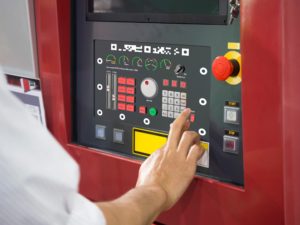Augumenta Receives Patent for its AR SmartPanel Machine Control
Since its founding in 2012, AREA member Augumenta has made a name for itself by delivering user-friendly interaction methods that leverage wearable devices. Now the Finland-based company is building on that heritage with a newly-patented technology that lets wearers of smart glasses control industrial machinery (and more) by interacting with a virtual panel called a SmartPanel. We spoke recently with Augumenta CEO Tero Aaltonen to learn more about this promising technology.
AREA: How would you describe what a virtual panel is and how it can benefit enterprises?
Aaltonen: It’s basically the same kind of panel that we are used to using today, but instead of being hardware-based, now it’s all done using Augmented Reality. So, it’s the same experience but done in a different way.
AREA: So instead of interacting with an industrial machine by turning physical dials and flipping switches, the user sees a virtual control panel through his or her smart glasses and is able to control the industrial machine with gestures. Talk a little bit about the advantages of that.
Aaltonen: There are many. One of the biggest benefits is that it eliminates maintenance costs because we’re only talking about black and white things on a flat surface. So, it doesn’t wear out and it never needs regular maintenance. That can be a significant savings over the lifetime of the panel. In addition, there’s no installation cost. That means we can have not just one of them, but many – as many as we wish. So, if you want to scale that interface across your factory, the price is not a limiting factor. You could have one or 10 or 100 in your factory and the cost is pretty much the same for the customer.
AREA: I would also imagine that, because modern factories change their product lines all the time, the SmartPanel enables them to reconfigure the control panel as needed, enabling them to be much more responsive to change.
Aaltonen: Exactly, and we actually have an easy-to-use design tool that’s accessible via a web browser. So, while it’s easy for us to change the panel, we made it so that the customers themselves can do all the customization without coming back to us. Also, when you have that level of flexibility in the UI it means that you can actually customize the UI by user or user group. So, if you’re the machine operator, you will see the operational. If you’re the maintenance person, it would show you the maintenance controls. It knows who you are in the organization.
AREA: So, rather than looking at a hardware panel that may have 30 different dials on it for a multitude of different users, each worker sees only those controls that relate to his or her job?
Aaltonen: Yes. We can simplify the design, bringing only the controls that are needed by that specific person. Then of course, with a simpler UI, the risk of human error goes down.
AREA: Tell us how this fits into the Augumenta business strategy.
Aaltonen: Augmenta started as a computer vision company, developing different types of interaction solutions for industrial customers. In our discussions with existing customers, we discovered there was a big demand for this kind of solution. And when we looked at the marketplace, we saw no one else was doing it, because it’s actually not that easy. There were a lot of algorithms that our in-house research team had to develop.
AREA: Who are the target customers for this solution?
Aaltonen: There are at least two types of customers. One is the company that builds industrial machines. The other one is the company that is operating the machines in the factory. They are buying machines from different vendors and they might want to get this kind of interaction from us so they can manage and control all the different machines. Many of these machines are moving to standard protocols, so it’s not that difficult for us to make a panel that can talk to a variety of machines.
AREA: What do you see as the primary use cases for the SmartPanel?
Aaltonen: One case is a highly-automated factory with few employees whose jobs are not to perform the manufacturing process, but to ensure that the machines keep running and products keep coming out. What happens often in these cases is that when an issue arises somewhere in the production line, the person that needs to fix it might be on the opposite side of the factory. So instead of having to walk across the factory floor to address the issue, they can do it at the nearest SmartPanel.
Another thing that we are seeing now is that these panels are being installed in locations that are environmentally very challenging with very harsh weather condition, or are in a location where there’s a risk that an unauthorized person could walk up to the panel and start using it. Because the SmartPanel is a flat black-and-white surface, it’s not affected by weather or environmental factors. And only people with the smart glasses and software can access it. So even if you have people trespassing, there’s nothing they can do when they get to the panel.
AREA: So, there’s a strong security aspect to it as well. If a company were interested in adopting the SmartPanel, how much time would it take to create a working solution?
Aaltonen: If customers are using standard protocols, we could get things up and running in two to four weeks. If a customer has older machines with more old-fashioned communication protocols, it takes a bit more time.
